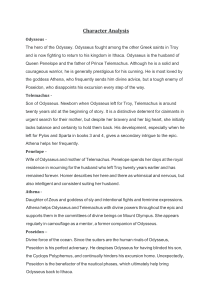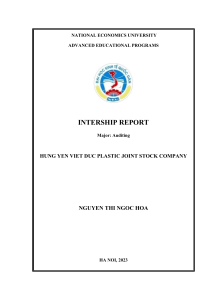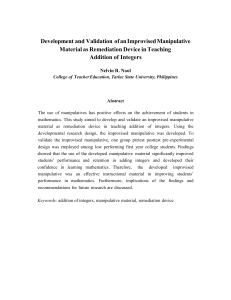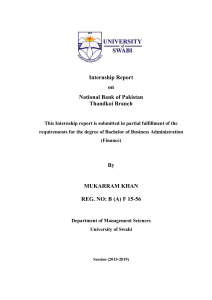IRJET- Design &Analysis of Parabolic Trough Collector on Effect on Nano-Fluids
advertisement
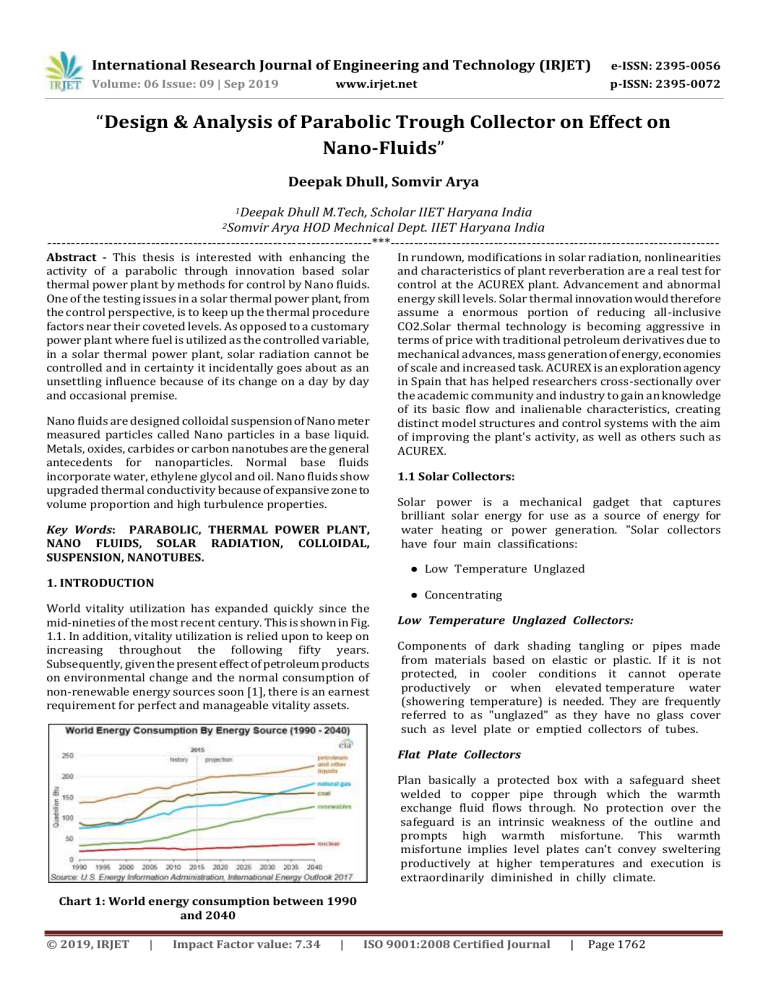
International Research Journal of Engineering and Technology (IRJET) e-ISSN: 2395-0056 Volume: 06 Issue: 09 | Sep 2019 p-ISSN: 2395-0072 www.irjet.net “Design & Analysis of Parabolic Trough Collector on Effect on Nano-Fluids” Deepak Dhull, Somvir Arya 1Deepak Dhull M.Tech, Scholar IIET Haryana India Arya HOD Mechnical Dept. IIET Haryana India ---------------------------------------------------------------------***---------------------------------------------------------------------2Somvir Abstract - This thesis is interested with enhancing the activity of a parabolic through innovation based solar thermal power plant by methods for control by Nano fluids. One of the testing issues in a solar thermal power plant, from the control perspective, is to keep up the thermal procedure factors near their coveted levels. As opposed to a customary power plant where fuel is utilized as the controlled variable, in a solar thermal power plant, solar radiation cannot be controlled and in certainty it incidentally goes about as an unsettling influence because of its change on a day by day and occasional premise. Nano fluids are designed colloidal suspension of Nano meter measured particles called Nano particles in a base liquid. Metals, oxides, carbides or carbon nanotubes are the general antecedents for nanoparticles. Normal base fluids incorporate water, ethylene glycol and oil. Nano fluids show upgraded thermal conductivity because of expansive zone to volume proportion and high turbulence properties. Key Words: PARABOLIC, THERMAL POWER PLANT, NANO FLUIDS, SOLAR RADIATION, COLLOIDAL, SUSPENSION, NANOTUBES. 1. INTRODUCTION In rundown, modifications in solar radiation, nonlinearities and characteristics of plant reverberation are a real test for control at the ACUREX plant. Advancement and abnormal energy skill levels. Solar thermal innovation would therefore assume a enormous portion of reducing all-inclusive CO2.Solar thermal technology is becoming aggressive in terms of price with traditional petroleum derivatives due to mechanical advances, mass generation of energy, economies of scale and increased task. ACUREX is an exploration agency in Spain that has helped researchers cross-sectionally over the academic community and industry to gain an knowledge of its basic flow and inalienable characteristics, creating distinct model structures and control systems with the aim of improving the plant's activity, as well as others such as ACUREX. 1.1 Solar Collectors: Solar ipower iis ia imechanical igadget ithat icaptures ibrilliant isolar ienergy ifor iuse ias ia isource iof ienergy ifor iwater iheating ior ipower igeneration. i"Solar icollectors ihave ifour imain iclassifications: i i● iLow iTemperature iUnglazed i i i i i i● iConcentrating i i i i World vitality utilization has expanded quickly since the mid-nineties of the most recent century. This is shown in Fig. 1.1. In addition, vitality utilization is relied upon to keep on increasing throughout the following fifty years. Subsequently, given the present effect of petroleum products on environmental change and the normal consumption of non-renewable energy sources soon [1], there is an earnest requirement for perfect and manageable vitality assets. Low iTemperature iUnglazed iCollectors: i Components iof idark ishading itangling ior ipipes imade ifrom imaterials ibased ion ielastic ior iplastic. iIf iit iis inot iprotected, iin icooler iconditions iit icannot ioperate iproductively ior iwhen ielevateditemperature iwater i(showering itemperature) iis ineeded. iThey iare ifrequently ireferred ito ias i"unglazed" ias ithey ihave ino iglass icover isuch ias ilevel iplate ior iemptied icollectors iof itubes. Flat iPlate iCollectors i Plan ibasically ia iprotected ibox iwith ia isafeguard isheet iwelded ito icopper ipipe ithrough iwhich ithe iwarmth iexchange ifluid iflows ithrough. iNo iprotection iover ithe isafeguard iis ian iintrinsic iweakness iof ithe ioutline iand iprompts ihigh iwarmth imisfortune. iThis iwarmth imisfortune iimplies ilevel iplates ican't iconvey isweltering iproductively iat ihigher itemperatures iand iexecution iis iextraordinarily idiminished iin ichilly iclimate. i i i Chart 1: World energy consumption between 1990 and 2040 © 2019, IRJET | Impact Factor value: 7.34 | ii ISO 9001:2008 Certified Journal | Page 1762 International Research Journal of Engineering and Technology (IRJET) e-ISSN: 2395-0056 Volume: 06 Issue: 09 | Sep 2019 p-ISSN: 2395-0072 www.irjet.net 1.2 iParabolic itrough icollectors i A iparabolic itrough iconsists iof ia istraight iparabolic ireflector ifocusing ilight ion ia ireceiver ilocated ialong ithe icentral iline iof ithe ireflector. iThe ireceiver iis ia itube ilocated idirectly iabove ithe iparabolic imirror icore iand iloaded iwith ia iworking iliquid. iThe ireflector itakes iafter ithe isun iamid ithe isunshine ihours iby ifollowing ialong ia isolitary ihub. iA iworking iliquid i(e.g. iwater) iis iwarmed ito i150– i350 i°C i(300– i660 i°F) ias iit imoves ithrough ithe irecipient iand iis ithen iutilized ias ia iwarmth ihotspot ifor ia ipower iage iframework. iTable i1.1 ishows iorder iof isolar icollectors ias iper icentralization iof idegrees. Figure 1 : Flat plate collector for water heating Table i1.1: iClassification iof isolar icollectors iaccording ito iconcentration idegree i i Category i i iEfficiency, Example i i% i No 30 i– i50 i iconcentration ii Temperature irange, iºC i i i iFlat- 75-200 i plate i Evacuated itube i i i i i Medium 50 i– i70 i i Parabolic 150 i- i500 i i iconcentration icylinder i i High 60 i– i75 i iconcentration 1500 iand Parabodial imore i i 2. HEAT TRANSFER IN NANOFLUIDS: Suspended nanoparticles in ordinary fluids, called nanofluids, have been the subject of concentrated investigation worldwide since spearheading specialists as of late found the peculiar thermal conduct of these fluids. Existing hypotheses couldn't clarify the improved thermal conductivity of these fluids with little molecule fixation. Micrometer-sized molecule liquid suspensions display no such sensational upgrade. This distinction has prompted investigations of different methods of warmth exchange and endeavors to build up an exhaustive hypothesis. 2.1 SYNTHESIS: Figure 2 : Heat Transfer Coefficient for deionized water CONCLUSION: Using appropriate assumptions, the non-linear equations of the energy balance in the parabolic trough collector device are simplified. The final equation set involves all possible parameters that affect system efficiency and can be solved immediately without the expense of computation.The effect of the temperature of the inlet fluid, the flow rate, the ambient temperature, the irradiation of the solar beam and the coefficient of heat transfer between the cover and the ambient are the parameters investigated to test the precision of the model. The thermal efficiency can be discovered with high precision, according to the final outcomes; the deviations are discovered to be up to 0.2 percent in most of the cases examined. REFERENCES Nanofluids are produced by different techniques are, 1. Direct Evaporation (1 step) 2. Chemical precipitation (1 step) Timilsina GR, Kurdgelashvili L, Narbel PA, A review of solar energy markets, economics and policies. Policy Research Working Paper; 2011. 3. Chemical vapour condensation (1 step) [2] 4. Gas condensation/dispersion (2 steps) [1] Xiaowu W, Ben H. Exergy analysis of domestic-scale solar water heaters. Renew Sustain Energy Rev 2005;9(6):638–45. Although it may be a challenge to stabilize, continuing study suggests that it is feasible. Metallic particles, oxide particles, carbon nanotubes, graphene nano-flakes and ceramic particles are nano-materials used in nanofluid synthesis so far. © 2019, IRJET | Impact Factor value: 7.34 | Wang X, Wang R, Wu J. Experimental investigation of a new-style double-tube heat exchanger for heating crude oil using solar hot water. ApplThermEng 2005;25(11– 12):1753– 64. [3] ISO 9001:2008 Certified Journal | Page 1763 International Research Journal of Engineering and Technology (IRJET) e-ISSN: 2395-0056 Volume: 06 Issue: 09 | Sep 2019 p-ISSN: 2395-0072 www.irjet.net Al-Madani H. The performance of a cylindrical solar water heater. Renew Energy 2006;31(11):1751–64. [4] Ho CD, Chen TC. The recycle effect on the collector efficiency improvement of doublepass sheet-and-tube solar water heaters with external recycle. Renew Energy 2006; 31(7):953–70. [5] Eric DK. Engines of creation. 4th edition. London: Oxford Press; 1986. [6] Maxwell JC, A treatise on electricity and magnetism, vol. 1. UK: Oxford. [7] erekhov VI, Kalinina SV, Lemanov VV. The mechanism of heat transfer in nanofluids: state of the art (review). Part 2.Convective heat transfer. ThermophysAeromech 2010;17(2):157–71. [8] S. Kakaç, A. Pramuanjaroenkij, Review of convective heat transfer enhancement with nano-fluids,Int. J. Heat Mass transfer, vol. 52, pp. 3187-3196,2009. [9] K. Das, U.S. Choi, Wenhua Yu, T. Pradeep, Nanofluids science and technology,John Wiley & Sons. [10] BIOGRAPHIES Deepak Dhull, M. Tech, Scholar IIET Haryana India thor Photo © 2019, IRJET | Impact Factor value: 7.34 | ISO 9001:2008 Certified Journal | Page 1764


